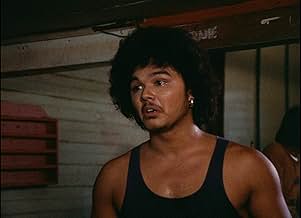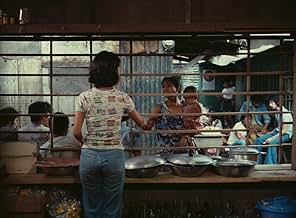CALIFICACIÓN DE IMDb
7.5/10
2.3 k
TU CALIFICACIÓN
Agrega una trama en tu idiomaThe life of a young girl living with her mother in the slums of Manila becomes unbearable when her mother's young boyfriend moves in with them.The life of a young girl living with her mother in the slums of Manila becomes unbearable when her mother's young boyfriend moves in with them.The life of a young girl living with her mother in the slums of Manila becomes unbearable when her mother's young boyfriend moves in with them.
- Premios
- 7 premios ganados y 12 nominaciones en total
Danilo Posadas
- Dado's friend
- (as Danny Posadas)
Opiniones destacadas
A strong, well written story, perfect casting and performances, clever staging and pacing make for a powerful love story, set in the slums of Manila. Insiang (Hilda Koronel) is tormented by an embittered mother (Mona Lisa), barely able to contain her anger at the husband who abandoned her for another woman and left behind their daughter to abuse and belittle. Tensions explode when Mom takes in a much younger lover (Ruel Vernal), who bides his time, ogling Insiang. Her boyfriends (Rez Cortez and Marlon Ramirez) are too young, too weak and too poor to do much for her, but the person who loves her most is eventually revealed.
A young girl named Insiang lives in the Philippines in dire poverty with her mother who treats her like dirt. Then her mother invites her lover Dado to live with them...but Dado only has eyes for Insiang.
Interesting and well-acted but VERY depressing. With the sole exception of the title character there's not one likable character in the entire film and the conditions that the characters live in is shocking. It is historically important as the first Filipino film to play at the Cannes Film Festival back in 1978 but it's so bleak.
Interesting and well-acted but VERY depressing. With the sole exception of the title character there's not one likable character in the entire film and the conditions that the characters live in is shocking. It is historically important as the first Filipino film to play at the Cannes Film Festival back in 1978 but it's so bleak.
Positives:
Negatives:
To sum up:
Just like Dado, the film hits two stones in one bird. It perfectly depicts the slum situation during that time while telling an excellent realistic revenge story that leaves the viewers satisfied. Insiang (1976) really shines in its relatable story and good characterization, successfully imbuing the protagonist's hardships in the hearts of the viewers. Yet, the film could still soar onto higher echelons if only the creators decided to polish minor inconsistencies as well as some unrealized storyline potential.
- Good picture of reality: The best asset of the film for me is its accurate painting of reality, specifically, the life from the slums. They shot it in a literal slum area so it convincingly conveys the vibe and atmosphere of these marginalized places. From the people's clothing, housing, way of life and attitude; they are captured by the film perfectly. Even the minor details shown in the film can accentuate the situation in the slum life such as when Insiang's mother urinates in front of her without any privacy.
- Perfect characterization: The characters from the film are fundamentally sound. They all have unique traits that depict their individuality and complexity, not just a typical character that can be sacrificed in the name of the plot. Every character, including the supporting casts, also has concrete motives that dictates their individual actions, allowing them to enrich the storyline.
- Simple but succinct storyline: The plot is simple, whereas every viewer can relate to it. But its simplicity is not a negative because of its compactness as it was told in a concise and inventive manner. For example, I like that the story starts in the thick of things, during the time where Toyang is about to shoo her relatives from her home. Most average writers will just start the story when Dado is already living in Toyang's home, just using petty flashbacks to paint the background of the characters. Not Mario O'Hara though. He is a magnificent writer.
- Good acting of Mona Lisa: Among all the artists, Mona Lisa is the one for me who got a timeless performance. Her acting during this film can still be considered very realistic even in today's standards.
Negatives:
- Insiang losing her character: I think the film did Insiang dirty. She suddenly lost her values during the last parts of the film, resulting in her character's inconsistency. How can a lass who refused to be touched by Bebot in the theatre suddenly allowed Dado to abuse her sexuality in the name of revenge? There is no turning point in the film that could be used as justification where Insiang decided that "enough is enough," going the dirty way to avenge herself. The motel scene is the closest justification but for me, the motel scene alone is not convincing enough.
- Rushed pacing during Dado and Insiang's affair: Another dud, albeit minor, is the rushed pacing of the film during Dado and Insiang's affair. It only consumes approximately 15 minutes of runtime. Viewers are only given a small window to heat up and realize that Dado has an ulterior motive of mingling with Insiang instead of Toyang. In my opinion, the climax could become even more satisfying if the film further extends the cut, capitalizing in the slow but emotionally powerful idea of Toyang losing her grip to Dado while the latter is pursuing Insiang.
To sum up:
Just like Dado, the film hits two stones in one bird. It perfectly depicts the slum situation during that time while telling an excellent realistic revenge story that leaves the viewers satisfied. Insiang (1976) really shines in its relatable story and good characterization, successfully imbuing the protagonist's hardships in the hearts of the viewers. Yet, the film could still soar onto higher echelons if only the creators decided to polish minor inconsistencies as well as some unrealized storyline potential.
Lino Brocka's 1976 melodrama of slum family love double-crosses was the first Filipino film to be shown at Cannes and is being revived at festivals. It deserves to be seen for the female actors, mother Tonia (Mona Lisa, credible as an aging lady who's still highly sexed and attractive) and gorgeous daughter Insiang (pronounced "Inshang"). Hilda Koronel, who plays Insiang, is enough like a Loren or a Lollobrigida to make you think of Fifties or Sixties Italian cinema and the visual style is conventionally of an early period, but this brutal story lacks the humanity and warmth of the Italians. Tonia drives a family of in-laws out of her shack (which is in with other families; in this barrio there is no privacy and all is known) because she can't feed them, but her ulterior motive is to bring in Dado, a handsome, macho man and a gambling no-good probably young enough to be her son, as her lover. Insiang has several young men interested in her, but the one she chooses is too cowardly and lazy to run away with her as she would like. Soon Dado puts the make on Insiang. It turns out badly for just about everyone in this miserablist drama, which has been compared to Fassbinder and Sirk. It's been commented that the story undercuts the two major values in Filipino film motherhood and the sanctity of the family. Brocka certainly keeps things lively, as do popular dramatic films from other Third World countries, and telenovelas. Yes, this holds the attention; but unfortunately the print used for the NYFF 2006 showing was an ugly-looking digital transfer that made all the boys look pimply and the shots look shoddy. Only Koronel's face shines through.
Forget the rest! Hilda Koronel's magnificent performance as the title character is enough to recommend this tale of rape and revenge, seduction and squalor, power and poverty. Hilda lives in a slum in Manila, maltreated by her domineering mother (Mona Lisa). Her mother has a lover (Ruel Vernal) old enough to be her son. Vernal, doing the lover bit because Lisa holds the household money, has his eyes set on Insiang. He rapes her but Insiang turns things around, getting Vernal to be her parasitic paramour. Great film noir, great performances.
¿Sabías que…?
- TriviaIn 1978, the movie became the first Filipino feature film to be presented in the Cannes Film Festival (Director's Fortnight) and to use Tondo as a shooting location.
- ConexionesReferenced in Ang anak ni Brocka (2005)
Selecciones populares
Inicia sesión para calificar y agrega a la lista de videos para obtener recomendaciones personalizadas
- How long is Insiang?Con tecnología de Alexa
Detalles
- Fecha de lanzamiento
- País de origen
- Sitio oficial
- Idiomas
- También se conoce como
- Das Mädchen Insiang
- Locaciones de filmación
- Tondo, Manila, Metro Manila, Filipinas(slum in Barangay 48)
- Productora
- Ver más créditos de la compañía en IMDbPro
- Tiempo de ejecución1 hora 35 minutos
- Mezcla de sonido
- Relación de aspecto
- 1.37 : 1
Contribuir a esta página
Sugiere una edición o agrega el contenido que falta

Principales brechas de datos
By what name was Insiang (1976) officially released in India in English?
Responda























